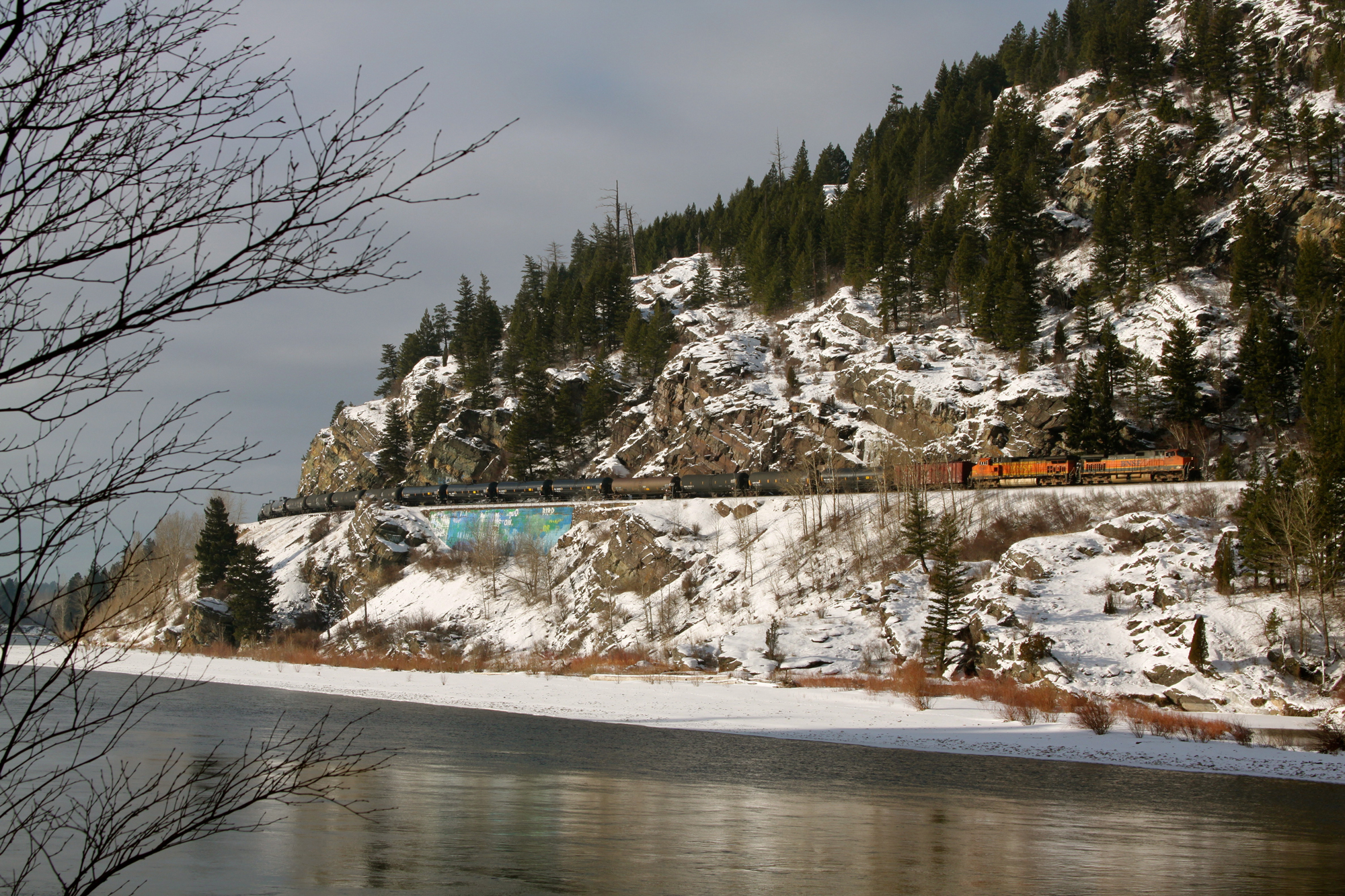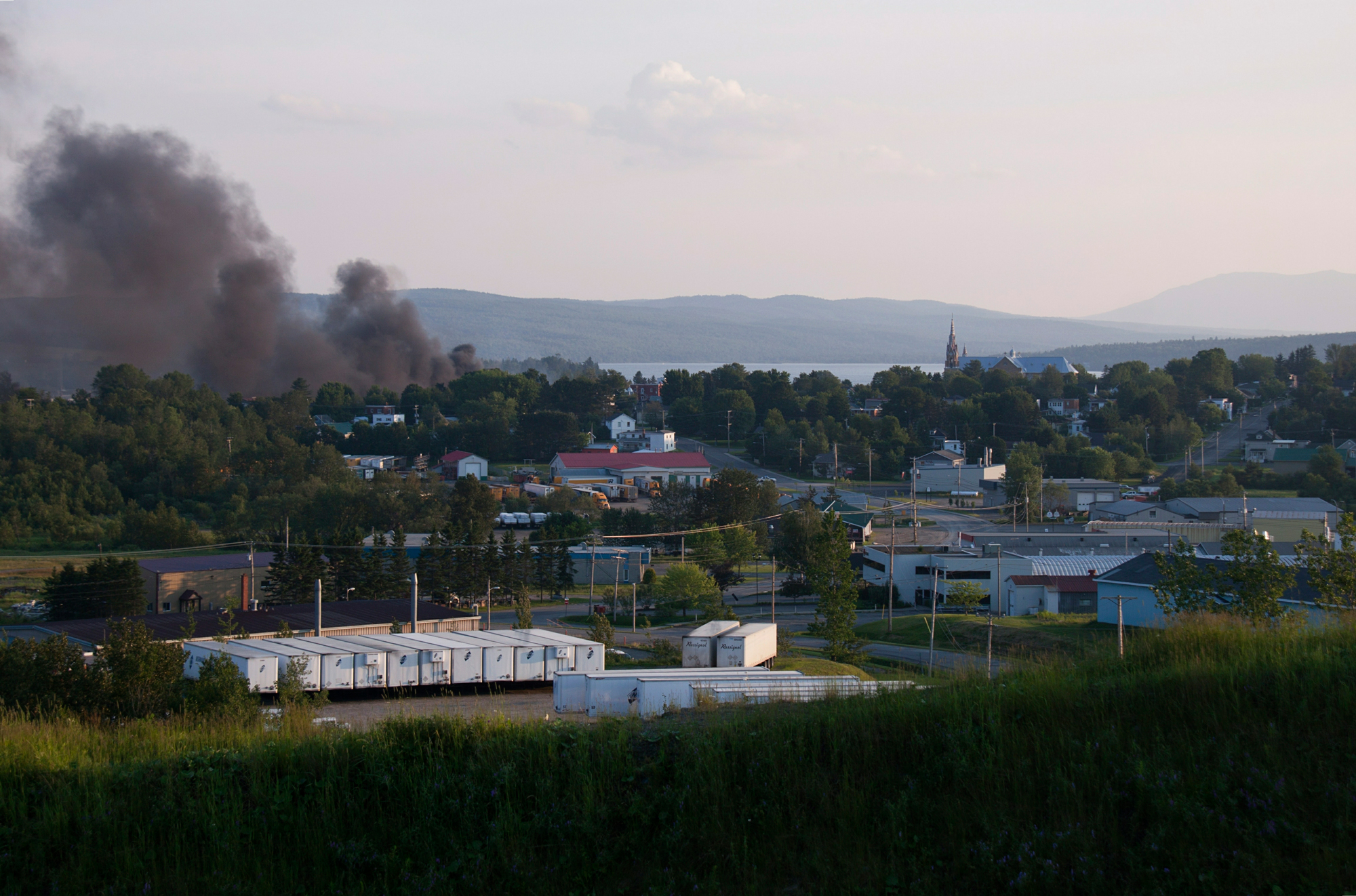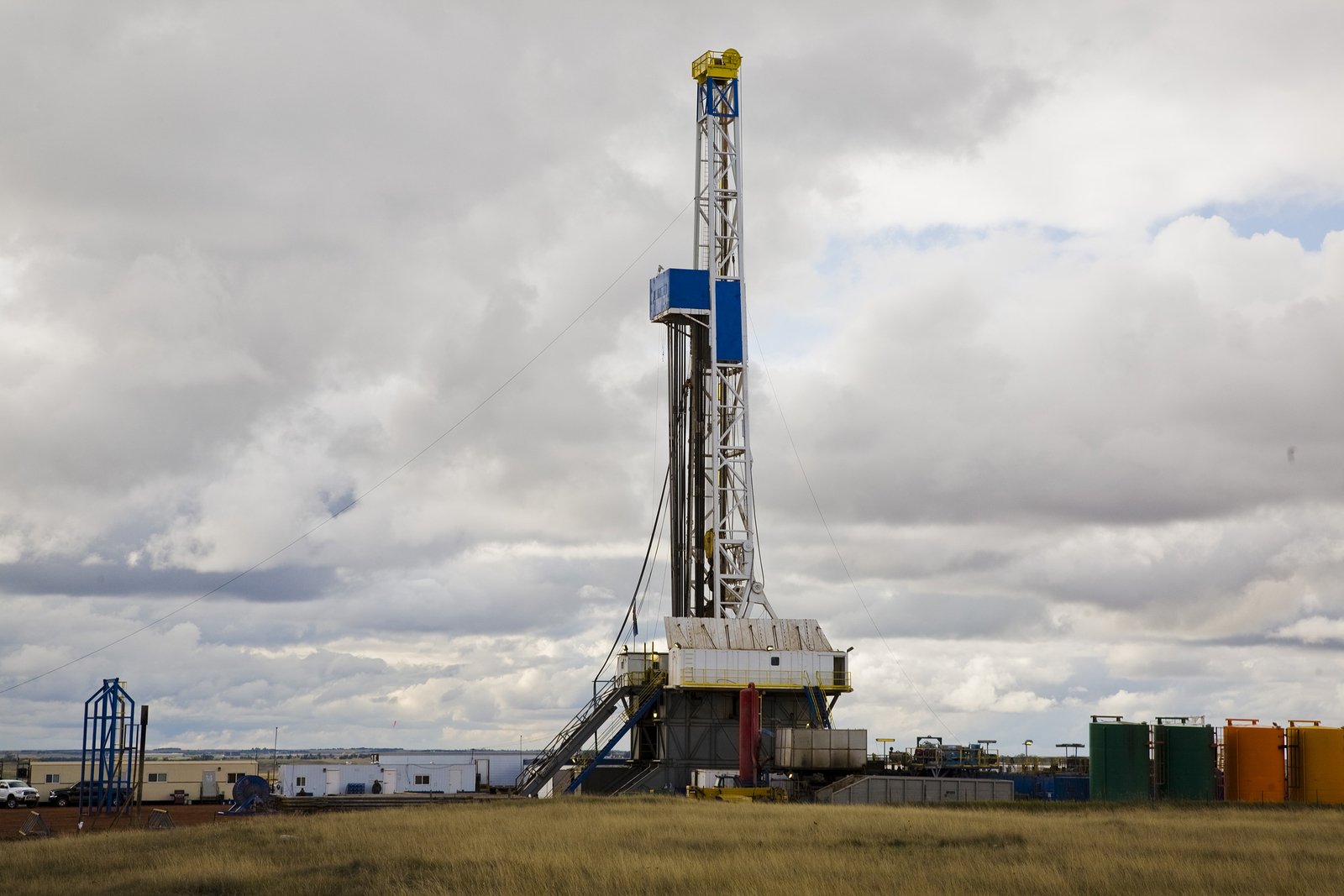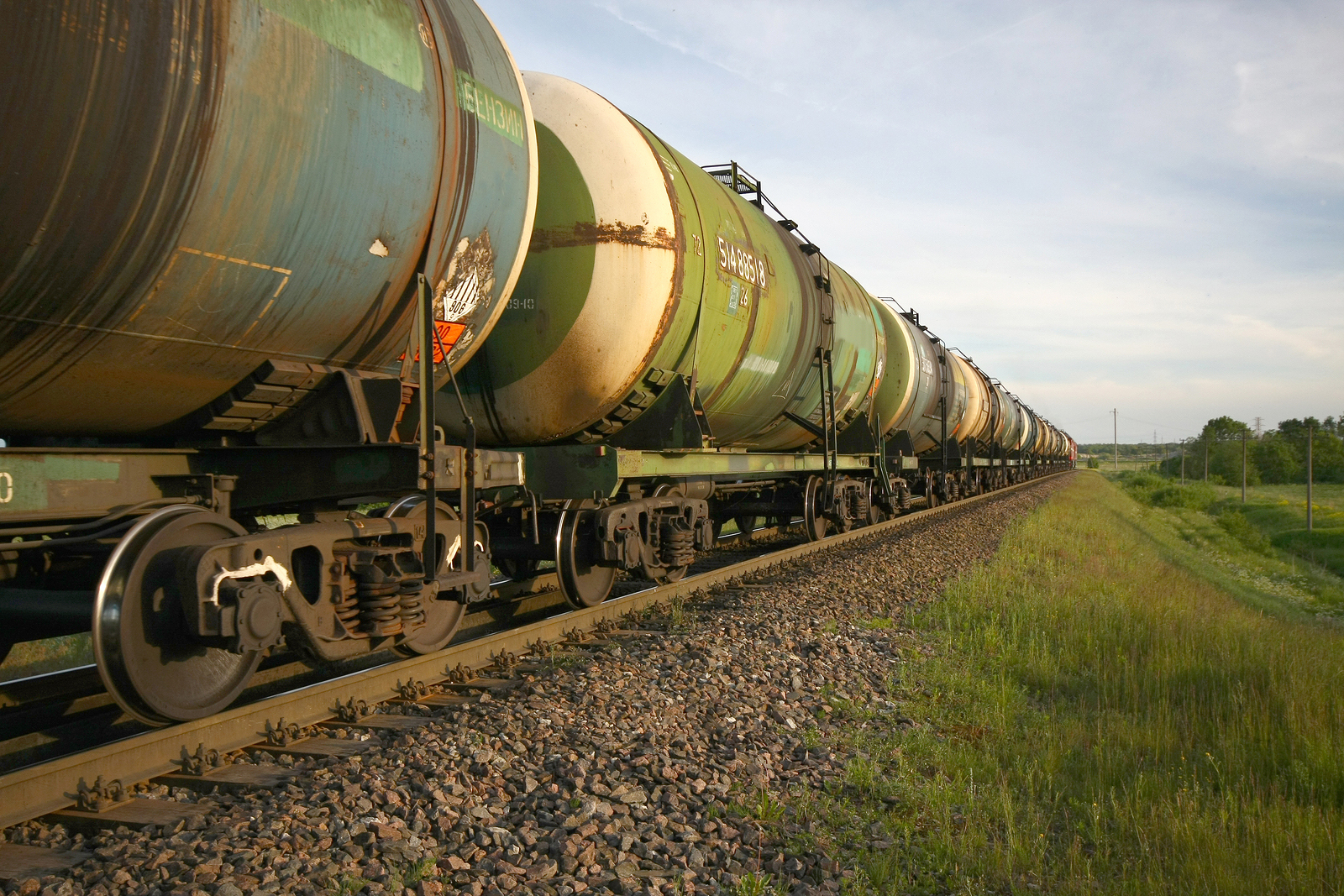Explosive Oil Trains
Air Date: Week of January 24, 2014

Oil train making the return trip to North Dakota for more Bakken oil (photo: Roy Luck, Creative Commons 2.0)
In the past year a number of explosive oil train derailments, including the deadly accident in Lac-Megantic in Quebec that killed 47 people, have raised important questions about how we transport oil in North America. Canadian journalist Jacquie McNish has written extensively about oil trains, and tells host Steve Curwood how we got here.
Transcript
CURWOOD: It's Living on Earth, I'm Steve Curwood. The US Secretary of Transportation, Anthony Fox, has called for the rail and oil industry to make voluntary changes aimed at preventing accidents. On January 16 Fox said industry executives have agreed to cooperate and will implement changes within the next thirty days, given the epidemic of disastrous accidents that has recently plagued North America. The immediate measures will likely include slowing the trains down and making risk assessments where trains pass through densely populated areas.
The litany of recent oil train disasters is long. Let me remind you of a couple: on December 30, a crude oil train went off the tracks near Casselton, North Dakota, exploding in a ball of flame and spilling 400,000 gallons of crude oil onto the plains. And last July’s catastrophic oil train derailment in Lac-Mégantic, Quebec set off fires visible from space and killed 47 people. Joining us now is Jacquie McNish. She’s a senior writer with the Globe and Mail in Toronto and has been covering the issue throughout the past year.

A fireball from the Lac-Megantic train derailment (photo: Public Herald, Creative Commons 2.0)
MCNISH: This is a story of a boom, a black gold rush in North Dakota of crude oil that had no other place to go. There were no pipelines, they started putting it on trucks, and then in 2009, a couple of folks in North Dakota, a couple of producers and shippers came up with an idea of moving it on the rails. And you will recall all the debate and all the fury that continues today over the pipelines...well, while everyone was focusing on pipelines, this quiet migration of oil shifted to the railways, a century-old infrastructure and cars that were designed for passengers, drygoods and lumber. We went from 4,000 tank cars of oil in 2009 to 400,000 tank cars in November.
CURWOOD: Where is all this Bakken shale oil going?

Lac-Megantic the day after the explosion (photo: Michel Gagnon, Creative Commons 2.0)
MCNISH: Most of it is being refined in the United States. Much of it done in the southern parts of United States. Also in Canada, in a province called New Brunswick on the east coast. One of the largest refineries in Canada owned by Irving Oil actually ships the stuff across the country from North Dakota on the rails and also by ships up the Hudson River to refine it there.
CURWOOD: Am I a customer of this oil here in Boston if I go to an Irving gas station? Am I buying this Bakken shale oil?
MCNISH: That's part of it. We're all using it. It’s blended and transferred into all sorts of...whether it's heating oil, whether it's gasoline oil, whether it's motor oil, it’s being refined everywhere, and it's making its way into the market for broad use.
CURWOOD: Now, to what extent is this heavy traffic causing more derailments?
MCNISH: There’s two things happening here. One, the railways themselves – they’re centuries old. Yes, they’ve upgraded the tracks, and yes, they’ve upgraded the cars, and the axles, but this is such a huge surge that it's...you know, you have to wonder that it’s putting stress on the rails, and the interesting thing about the derailments that we’re seeing now is that most of them are occurring on what we call short lines.
The big class one railways - Burlington Northern or Canadian Pacific or Canadian National here in Canada - they take the oil out of the Bakken region, but to get it to the refineries often they have to use the regional short line railways. Lac-Mégantic, it was Montreal, Maine Railway, a very small troubled rail organization whose tracks were not up to the same levels as the tracks of the class one. In Aliceville, Alabama, they had a derailment of Bakken oil in November, it was a small short line going through a swamp. In Casselton, North Dakota, once again it was a smaller line, feeder line, before it got onto the big line.
CURWOOD: Describe for us the Aliceville, Alabama, accident?
MCNISH: Aliceville, Alabama, happened in November. This was oil from the Bakken region that originated from North Dakota, made its way across the Midwest and was traveling through Alabama in mid- November, and according to the local reports, late in the evening, some of the cars were going over...the entire train was going over a trestle, slightly raised trestle about 10 feet above the swamp... and very open space surrounded by swamp, and a couple of the cars derailed and the next thing you know there are fireballs unleashing into the air, and this train burned for three days. Now the good news about the derailment, it was just a mile or so outside of the small town of Aliceville. It was not an inhabited area, it was in a swampland area, but it's amazing looking at the pictures of the fire and of the trains themselves crumpled like an accordion of burned tankers, very much like Lac-Mégantic.
CURWOOD: How much oil was in the Aliceville derailment?
MCNISH: I don't know the exact number, but I believe it was 12 to 14 cars that derailed, and there was a lot of spillage into the swamp. It's, it's interesting how the railways respond to these things. They say, well, fortunately there was a beaver dam so it protected the oil from getting into other parts of the swamp. [LAUGHS] That was one of my favorite responses to that accident.
CURWOOD: So who are the regulators that are keeping track of the quality of the rail lines that this stuff is being transported on?
MCNISH: Well, that is a good question. You know, what we discovered both in the US and Canada is that no one publicly called for any scrutiny, any new rules, or even a review of the potential dangers posed by the largest increase in hazardous materials ever on the rails.
CURWOOD: Talk to me about the oil itself. You know, when you look at some of the pictures of the accident it seems to be pretty explosive.
MCNISH: And that was how we got involved in this story. When Lac-Mégantic occurred, there was a lot of video footage because it happened in the downtown and the residents that survived and were able to run, they all turned on their cell phones and took these images, and it was...it looked like a war zone...mushroom clouds of burning oil. And if you know crude, it doesn't behave like that. You can throw a lit match into a tank of crude oil, because it’s so thick, and the chances are, it will extinguish itself because it just doesn't have a low flammability point.
This stuff exploded immediately on impact, and at first, the theory was that there were propane tanks in the town - that has been discounted. And then the industry responsible by the rail and the petroleum sector was, this was a once-in-a-lifetime accident - there was a hill, the brakes broke loose and the rail cars had nowhere to go, they crashed into each other, and punctured and exploded. So that was the narrative. And then we had Aliceville, Alabama, happen, and if you look at the pictures and you lay them side-by-side, the sort of accordion of burning tank cars, and again, mushroom clouds... Casselton, the same thing. So something is going on here, and initially people would say they're focusing on improving the security and the emergency response of the trains. Now they’re actually looking at the oil itself.
CURWOOD: What about the properties of the oil? Is it somehow more volatile?
MCNISH: I wish I could say I knew a lot about it, but the sad fact is, is that no one’s really taken a hard look at it. We went to Newtown, North Dakota, and you look at this oil and it looks like honey in a mason jar. It's very light, and the light qualities are part of the story here. The other story is what are the other elements? And one of the elements that people started to look at in 2010 at a joint government and industry think tank was hydrogen sulfide. Now hydrogen sulfide does exist in all oils, but in this particular oil - it’s called a sweet light crude and that's why it's prized, easy to refine, not so much sulfide you have to remove, but if you talk to geologists and scientists they say inevitably sulfides do creep into sweet light oil, and so we wonder and we can only wonder because no one’s actually studied this, you know, are we seeing this light sweet oil become contaminated four or five years into this gold rush, has it become a problem? And the reason it's a more of a particular problem for light oil is it if you transport this stuff and if there's heat or if there are disturbances you can start to see the oil actually stratify and begin the refining itself in the tank car, which means you're producing gases that are highly combustible on impact or if they don’t vent properly.
CURWOOD: To what extent do you think the chemicals involved in the fracking process of the oil might be part of the problem?
MCNISH: That is at this point only a theory. We do know that that the oil producers in the fracking process use benzene and other chemicals to help remove the oil that’s locked into the shale below the surface. They will tell you that it’s only minute amounts that are used of benzene and other chemicals, so it’s inconceivable to them that it would be a problem. We also know from the first emergency responders at Lac-Mégantic that there was a lot of benzene - pools of benzene, they described - pooling outside the area where the trains derailed after the fire had been doused so that you know it’s hard to understand why there would be so much benzene. Was it a chemical reaction after the fires? Was there an excess amount in those tank cars? These are all good questions. There's no, there's no solid scientific proof or testing to prove it one way or another, and, you know, clearly there is a need to ask that question in a much more thorough scientific manner.
CURWOOD: So it may well be that relatively volatile, indeed, explosive materials were going through all these towns along the rail lines. To what extent are folks informed that this stuff is coming through and what say do they have about it coming through?

A North Dakota oilrig. (photo: bigstockphoto.com)
MCNISH: That’s a very good question, and I find it fascinating as a journalist that everyone is so focused on Keystone and all for legitimate reasons. And people will talk about the corruption of the Boreal forests in western Canada where they are planning to put part of the pipeline, but no one is thinking about these pipelines of oil that are moving to their communities. Railways were built before many towns were built, so as a result the railways travel right through the center of most towns and cities, and people seem to not be focused on the potential dangers. In the wake of these accidents they are paying attention. You're seeing more communities having standoffs with the railways, asking for information. Communities are now talking about getting some sort of 24 hour notice. What the railway will say, and what the government will say is that they're very careful about any information they provide. They’re worried about terrorism and other risks, so there's a lot of push and pull here to get better information and more coordination. We’re not there yet. A lot of the railways, particularly in Canada, constitutionally have more rights than the communities. They get to decide when and how they push the trains through. That's causing a lot of friction. There’s so many trains now in parts of Canada, particularly in the oil districts, where you have to wait 20 minutes to get from one part of town to another. It can be a small town of 400 people, but there’s nothing you can do, the train will go when it wants to go.
CURWOOD: Which of these towns is mounting a fairly active protest?
MCNISH: We have Calgary, Alberta, it’s the largest city in the Midwest of Canada, and they have had a couple of derailments and a couple of standoffs with the Canadian Pacific Railway, one of our largest railways, and they seem to be working out a healthier dialogue right now. There is a conference taking place next month in Calgary, citizens' action group holding a discussion on the safety of oil and other hazardous materials on the rail, so people are starting to think more more of this. And the interesting thing is there is still a lot of inertia...there was a deadly ethanol explosion in Illinois in 2009 that killed some people that were waiting in their cars - the fires immediately killed those people - and as early as 2009, the regulators after investigating this were recommending studier cars.

In the absence of pipelines, trains have become a primary transportation option for North American crude oil. (photo: bigstockphoto.com)
18 of those tankers were punctured in that derailment, unleashing a fiery ethanol explosion, and the industry -- the regulators calling for some time for upgraded double-walled tank cars that have shields on both sides to help prevent puncturing when there is a derailment, and better venting so if there are gases they can get out. And the shippers actually own these tank cars, not the railways. The railways just carry them. The shippers have pushed back on a lot of that, and now we’re seeing in the wake of Lac-Mégantic and these accidents, more initiative, even the Railway Association of the United States has issued a public statement in November saying that they favor conversion to the secure cars.
CURWOOD: So how has the string of oil train accidents had an impact on the pipeline debate, both in Canada and here in the United States?
MCNISH: I think people have ignored this, they have ignored it because they basically created a new pipeline on the rails through the back door and nobody stopped them. Nobody said you can't do this, nobody said you have to take extra security measures, and people just stood there watching these large black trains of oil go by their communities without asking questions. I mean, we all have to look at ourselves and say how did this happen? Why didn't anyone intervene? We didn't do it as citizens and our government certainly didn't raise any questions or increase their scrutiny.
CURWOOD: In view of the danger of these oil train accidents, how do you think that affects the argument of the necessity to get off of fossil fuels?

Jacquie McNish (photo: Globe and Mail)
MCNISH: That's a big question. That’s a big geopolitical question. I think that in this case, in this story, the story of North Dakota oil and all that oil going on the trains, there was a geopolitical economic imperative, that imperative was the United States is dependent on oil, and suddenly this little place called North Dakota is rapidly becoming the largest producer of oil in the United States. It’s now number two behind Texas, and by 2015 the US is destined to be oil independent. What government is going to stand in the way of that? What consumers are going to give up driving their cars to work for the jobs that they need? I mean it’s a very complicated question, our dependency on fossil fuels. I think a more reasonable manageable way of approaching this is, what are we doing to ensure safety? Not enough.
One of the things that was very revealing about the investigation that we did is that the US Federal Transportation Department was doing what they called the Bakken blitz - they were investigating complaints about the corrosive nature of the Bakken oil that was corroding the cars, leading to some puncturing, lots of complaints about something was wrong with this oil. That was two months before the Lac-Mégantic accident. Did they do anything about it? No. They are doing a lot more now because there's been this tragedy and there’s 47 people dead. At a baseline, we could be a lot smarter about how we transport this stuff.
CURWOOD: Jacquie McNish is a senior writer with the Globe and Mail in Toronto. Thanks so much, Jacquie, for taking the time.
MCNISH: Thank you.
Links
Read more about oil trains from Jaquie McNish at the Globe and Mail
Living on Earth wants to hear from you!
Living on Earth
62 Calef Highway, Suite 212
Lee, NH 03861
Telephone: 617-287-4121
E-mail: comments@loe.org
Newsletter [Click here]
Donate to Living on Earth!
Living on Earth is an independent media program and relies entirely on contributions from listeners and institutions supporting public service. Please donate now to preserve an independent environmental voice.
NewsletterLiving on Earth offers a weekly delivery of the show's rundown to your mailbox. Sign up for our newsletter today!
 Sailors For The Sea: Be the change you want to sea.
Sailors For The Sea: Be the change you want to sea.
 The Grantham Foundation for the Protection of the Environment: Committed to protecting and improving the health of the global environment.
The Grantham Foundation for the Protection of the Environment: Committed to protecting and improving the health of the global environment.
 Contribute to Living on Earth and receive, as our gift to you, an archival print of one of Mark Seth Lender's extraordinary wildlife photographs. Follow the link to see Mark's current collection of photographs.
Contribute to Living on Earth and receive, as our gift to you, an archival print of one of Mark Seth Lender's extraordinary wildlife photographs. Follow the link to see Mark's current collection of photographs.
 Buy a signed copy of Mark Seth Lender's book Smeagull the Seagull & support Living on Earth
Buy a signed copy of Mark Seth Lender's book Smeagull the Seagull & support Living on Earth

